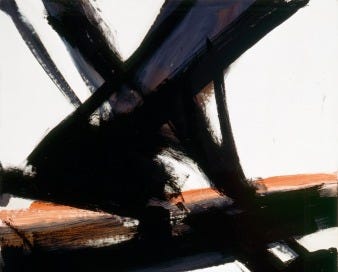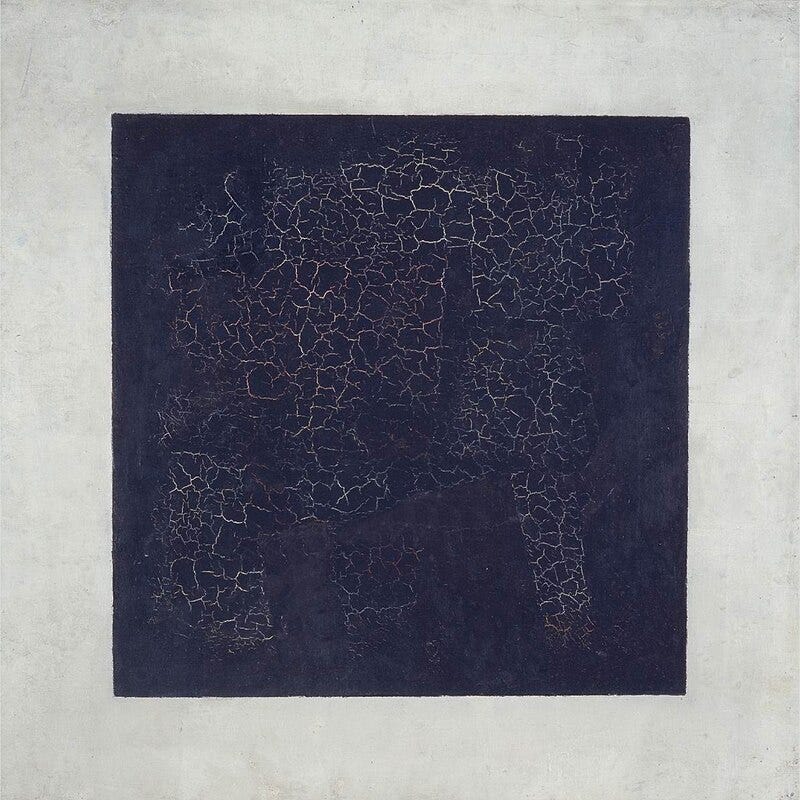Art's Party For the End of the World
Shock Art, the Black Square & the ethics of pushing boundaries.
Art's Party For the End of the World
"An uncrossable line (…) between old art and new art." —Tatyana Tolstaya.
Like a theme park of beautiful destruction, the Black Square is met with gasps and sharply pained inhalations. “But why scream? Why gasp?” Because the Black Square challenges everything; the sun, the color, the form, the light, the shadow. It challenges all principles in art yet remains one of the most influential paintings in the history of it. It's a silent scream. A protest against a world obsessed with meaning, with progress, with truth. To stand before the Black Square is to stand before the intolerable, that perhaps there is no meaning in life, in art, or in anything.
From this notion, there was no provocative invitation to find meaning in the Black Square. There was only an order that you face the possibility—the painting—of that there is none. So the viewer is left with themselves, staring back from the black abyss into their core, wondering where the boundaries truly lie, or if they ever did exist.
Secondly, it exists as the degradation of everything; as the personification of God’s death; as the tipping point. It’s one big, fat “fuck you!” to art, with Rembrandt and Vermeer looking down. Past all beauty, all art history, all conception of space and perspective, Malevich makes no effort in dramatization; he portrays his subject, nothingness, as is. When other painters of his time were busy vigorously studying color theory and facial proportions, Malevich didn't tire, he saw eventuality and made the leap without hesitation.
Malevich leaped over all the styles that could be and became “suprematist,” in his words, superior. He concluded that when all colors—all futures, all pasts—are mixed they create black; the absence of color and time. Malevich proposed his hypothesis with the Black Square, stating that when everything is created, when all boundaries are eradicated, the world collapses in on itself, exploding into nothingness.
Before Malevich, hundreds upon hundreds of years had culminated into great Renaissance beauties and impressionist sunsets that fit the ideal image of beauty. But, Malevich, rejects this. He states that, no, in the end, art does not culminate in beauty, instead it culminates in nothingness. Wherein lies the genius with Malevich’s claim is that, in 1913, he was just beginning to see the exponential fragmentation of the art world (with the rise of Fauvism, Impressionism, Cubism, and many others) and he very cleverly made the conclusion that with this continued massive fragmentation, art’s fabric–its shape–shall finally collapse into the product of all colors and styles, black.
Malevich was spot-on in his observation, both in the art world yet chiefly in history as a whole. Firstly, a lack of social cohesion is directly associated with worsened mental well-being and, at large scale, can lead to collapse of entire societies. Secondly, this sociological tenet is shown time and time again in history. The Roman Empire’s fall is largely attributed to a relative lack of social cohesion near the final years of the society. Furthermore, in the USSR, whole population centers and government sectors were frequently forcibly fractured from the society. This, leading to a general lack of social cohesion and consequently an increase of national stress–ultimately, resulting in the collapse of the USSR.
But, from the claim above, if I were to swap the phrase social cohesion with artistic cohesion and write that it’s directly associated with worse art and collapse of whole styles in it, the striking similarities across art and general history become clear.
I find Malevich to be brilliant in the way he displays these messages. Cultured, refined, organized, all while being revolutionary for his time. Yet, a considerable portion of post-Malevich visual art is, unlike Malevich, ostentatious; totally unsubtle; utilizing unnecessary vulgarities, oftentimes only for shock value and solely for the sake of pushing boundaries.
For example, Merde d’Artiste (Artist’s Shit) is a rebellious piece made for the sake of being rebellious. Some philosophical statements could be extracted from the art, but it all essentially boils down to an esoterically stated byproduct of what seems like an angsty teen’s rebellion.
Do I think that it’s bad art? Yes, I do not like that art. I think it takes little imagination and little effort to make, and I know the singular reason it’s valued is because it was the first piece of art to legitimately be almost exclusively shit—merely a gimmick. I find Merde d’Artiste valued in the same way someone might value a drink or a cigarette—marked by fleeting importance; paltry novelty. Manzoni expresses some of the same overarching views as the Black Square yet with less complexity and with more degeneracy, leaving the piece to be merely low-class shock art, having no real thoughtful elaboration on Malevich’s already established themes (or any new, compelling themes for that matter).
The piece is like a stupid world record. Is it cool and interesting that you shoved seventy-six hot dogs into your face in ten minutes? Kind of. But is it enviable or an action that projects an understated message onto the world? Definitely not.
Contrastingly, the Black Square is masterfully executed as its focus goes beyond shock and prompts profound introspection which had not been considered in its time. Furthermore, I believe Malevich predicted the rise of this tasteless shock art. He set the final boundary; the boundary marking the end of art’s party for—until—the end of the world; the party of disrespecting customs until there is no more to disrespect. Malevich reduced art to its final essence; black, nothingness, because he knew that once boundaries begin to break, they will never stop being broken. He understood that artists will destroy every boundary in their path until all colors mix together, creating black. And he understood that society is predicated on destroying boundaries–there’s rarely been a time in history where normalcy was wholly respected.
Yet, even with this notion—that I don’t think many would doubt—groups against pushing boundaries almost always end up on the wrong side of history (and I likely will as well). Segregationism, homophobia, Romanticism, these movements once represented the norm. Now, the total opposite. Am I a segregationist? A homophobic? Of course not. I’m just wondering if society will ever draw the line to halt the customs of today from being eradicated. Perhaps today’s customs are flawed, but it’s hard to imagine that certain foundational norms won’t persist.
Surely, surely, there are norms that will be upheld because they’re reasonable, reasonable, and just, right?… That is, as I conclude, for history—for art—to decide.







Thanks for the excellent piece. Please cut the cuss words. Use --- these instead